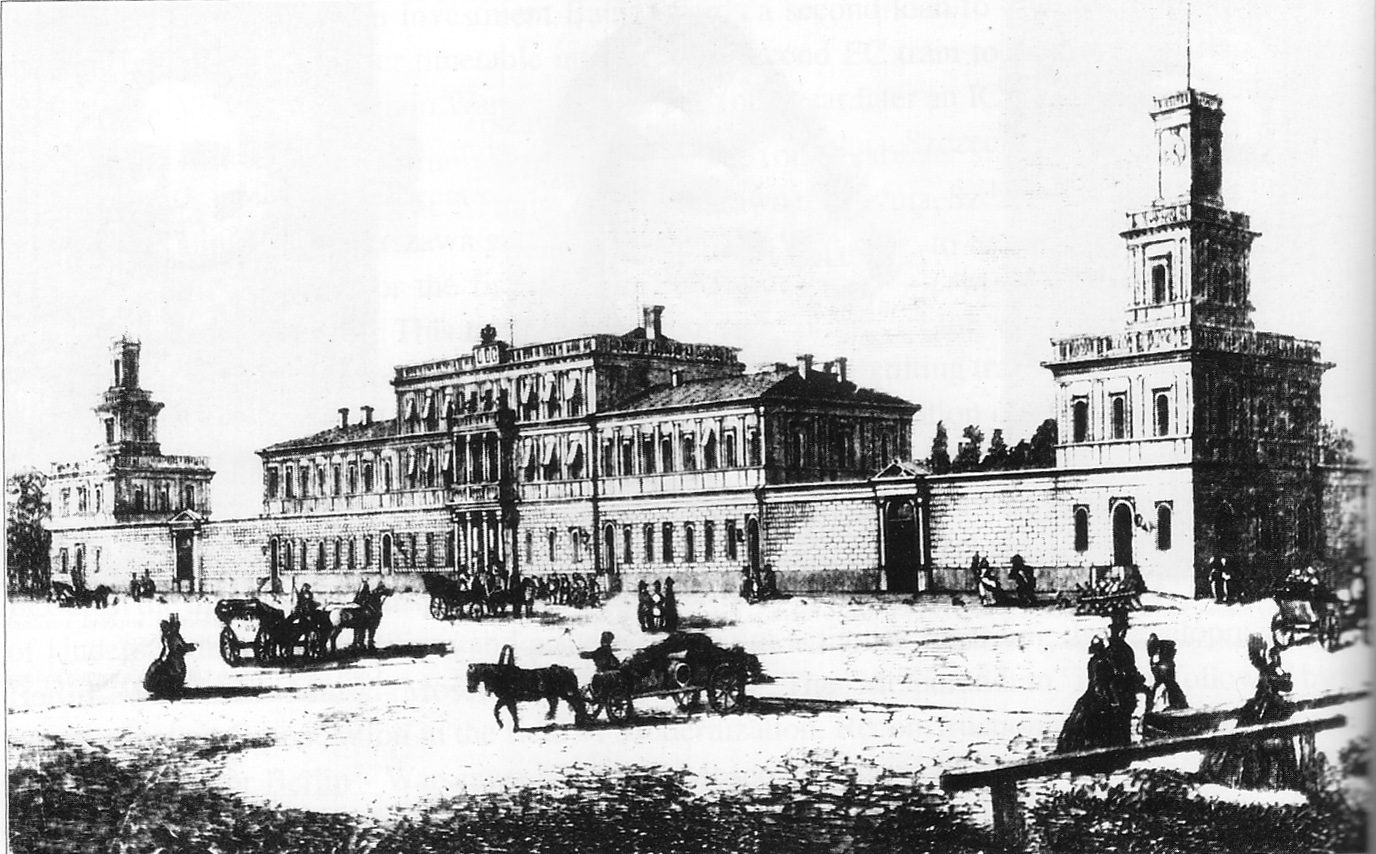- Warsaw-Vienna Railway

right|thumb|Vienna Station in Warsaw, the starting point of the Warsaw-Vienna RailwayThe Warsaw-Vienna Railway ( _pl. Kolej Warszawsko-Wiedeńska) was arailway system which operated inCongress Poland , a part of theRussian Empire , from 1845 until 1912, when it was nationalized by the Russian government. The main component of its network was a line 327.6 km in length fromWarsaw to the Granica (English: "Border") station (today Maczki, located in a suburb ofSosnowiec ) on the border with theAustrian Empire , from 1867 known as theAustro-Hungarian Empire . There the line reached the Austrian railway network, offering connections i.a. toVienna (hence the name of the line). It was the first railway line built inCongress Poland and the second in the Russian Empire, after a short stretch of 27 km betweenTsarskoye Selo andSaint Petersburg which opened in 1837Rakov, V.A.: "Lokomotivy otechestvennyh zheleznyh dorog 1845-1955", Moscow 1995, ISBN 5-277-00821-7, p.10] . The line used the standard European gauge (1435 mm), as opposed to all other railways in the Russian Empire which used the broad gauge (1524 mm), hence it formed a system physically separated from other Russian railways.History
Ownership
The first concrete plan to build a railway between Warsaw and the southern border of the
Congress Poland was submitted to "Bank Polski" (Polish Bank) in January 1835. Three years later, in 1838 "Towarzystwo Akcyjne Drogi Żelaznej Warszawsko-Wiedeńskiej " (Warsaw-Vienna Rail Road Company Ltd) was established and granted a licence to build the railway.Arguments between proponents of horse and steam traction lasted many years, and only in 1840 the latter was chosen when the building work started. The company went bankrupt in 1843 and was taken over by the state.In 1857 the line was leased to a private company (also called "Towarzystwo Akcyjne Drogi Żelaznej Warszawsko-Wiedeńskiej") for 75 years, however it was re-nationalised in 1912, with a compensation paid to the shareholders (mostly Belgians and Germans).Permanent way
The first stretch of the line, from Warsaw to Grodzisk Mazowiecki (30 km), opened on 14 June 1845, and got extended to Skierniewice with a branch to Łowicz on 15 October 1845. The trains reached Częstochowa in 1846, Ząbkowice in 1847 and Granica on 1 April 1848. There were 27 station on the line.
Initially the line was single, but from the beginning the earthwork was done in preparation for the second track, which was gradually added to the whole route between 1872 and 1881.Stations
*The Warsaw terminus (Vienna Station, _pl. Dworzec Wiedeński), designed by
Enrico Marconi , opened in 1845 and remained in use for over 75 years. The building, facingAleje Jerozolimskie , was 166 metres long and 18 metres wide, with the three storey central part, flanked by two 25 metre towers. The western tower housed anoptical telegraph station on the top floor, the eastern one had a clock.
*Marconi designed also the southern terminus of the line, in Granica, on a much more modest scale.Rolling stock
The first five locomotives were purchased from
John Cockerill 's factory in Seraing. Later on additional engines were obtained from Borsig and other West European factories. From 1901 locomotives were Russian-built, but different from common Russian stock.Route
Main line:
Warszawa -Grodzisk Mazowiecki -Skierniewice -Koluszki -Piotrków Trybunalski -Radomsko -Częstochowa -Zawiercie -Ząbkowice Będzińskie -Strzemieszyce Południowe - Granica (border with Austria)Branch lines:
*Skierniewice -Łowicz
*Ząbkowice -Sosnowiec
*Koluszki -Łódź -FabrycznaReferences
* [http://www.pkp.pl/klubpkp/historia Polish State Railways: history pages]
* [http://www.tpkww.one.pl/historia/dzww.php History of the line] by Friends of the Warsaw-Vienna Railway, Częstochowa
* cite book
last = Stawarz
first = Andrzej (ed.)
authorlink =
coauthors =
title = Gdy do Grodziska ruszył parochód
publisher = Tow. Przyjaciół Grodziska Mazowieckiego
date = 1990ee also
*
History of rail transport in Poland
Wikimedia Foundation. 2010.
